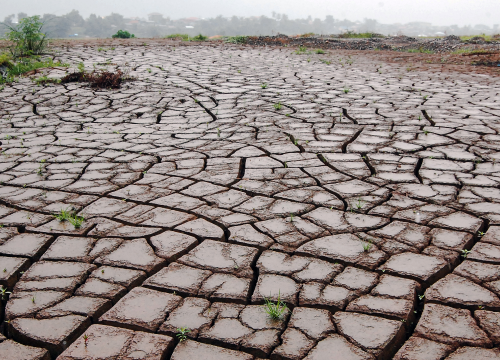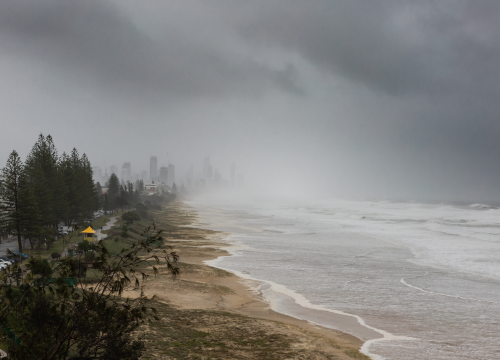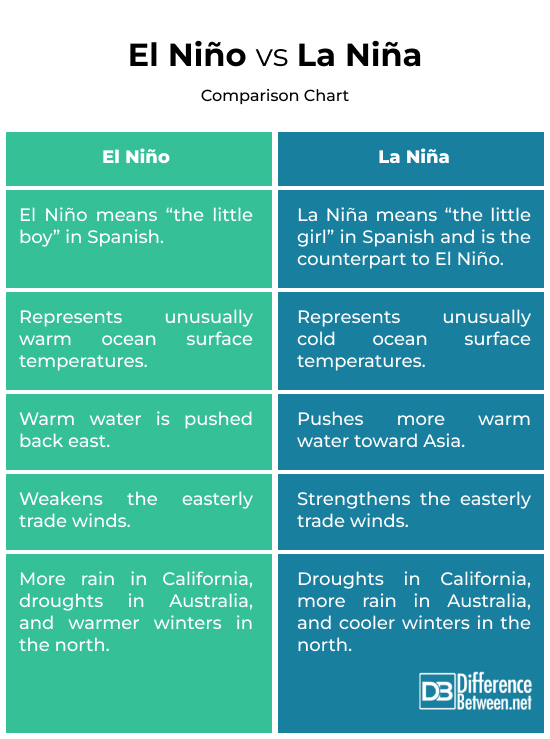Difference Between El Nino and La Nina
In the El Niño-Southern Oscillation (ENSO) climate pattern, El Niño and La Niña are the opposite phases that occur in the climatic pattern. These are variations of the climate system that occur without human intervention and are produced in the Pacific Ocean as a result of interactions between the ocean and the atmosphere.
The first phase of a recurrent climate pattern is the warm phase, and the second phase is the cold phase respectively. These events have a huge impact on the weather patterns that occur all over the world.
In this article, we will provide a concise explanation of El Niño and La Niña, as well as a discussion of the primary distinctions that exist between the two.

What is El Niño?
The El Niño phenomenon is a climate pattern that occurs naturally and is characterized by sea surface temperatures that are higher than the average over the tropical Pacific Ocean. The warm phase of the ENSO cycle is represented by this specific climate pattern, which is a part of the larger ENSO climate pattern.
In a typical scenario, powerful trade winds sweep across the Pacific from east to west, causing warm surface water to be pushed towards Asia. The winds that blow during El Niño tend to become weaker or perhaps blow in the opposite direction entirely.
Because of the decreased wind, warm surface water is pushed eastward, which results in the eastern Pacific becoming much warmer than typical. As a result of this warming, the typical patterns of circulation in the ocean and the atmosphere are disrupted.
The occurrence of El Niño occurrences is erratic, frequently occurring every two to seven years, and their intensity varies. While some occurrences are quite insignificant, others can be extremely powerful and have noteworthy effects on a global scale.

What is La Niña?
Known as the opposing phase of the ENSO pattern, La Niña is a climate phenomena that occurs with these characteristics. It is distinguished from El Niño by the fact that it is characterized by ocean surface temperatures that are lower than the average in the central and eastern tropical Pacific Ocean. In contrast to the warmth that is witnessed during El Niño episodes, this cooling is the reverse of that.
The Pacific Ocean is characterized by powerful trade winds that blow even stronger, which causes warm water to move westward. Consequently, this results in an increase in rainfall in the western Pacific region, which includes Southeast Asia and Australia.
Similar to El Niño, La Niña has the ability to influence weather patterns all over the world, although it has a different impact in certain locations. It has the potential to have a big influence on both the ecology and agriculture. In contrast, it frequently brings circumstances that are drier and warmer to the regions that are located in the central and eastern Pacific.
Difference between El Nino and La Nina
Ocean Temperature
While both are recurring climate patterns in the Pacific Ocean that impact weather globally, their effects are opposite. El Niño is characterized by warmer-than-average ocean surface temperatures in the central and eastern equatorial Pacific.
La Niña represents the opposite phase of the ENSO pattern. Unlike El Niño, it’s characterized by cooler-than-average ocean surface temperatures in the central and eastern tropical Pacific Ocean.
Trade Winds
Normally, strong trade winds blow from east to west across the Pacific. During El Niño, these winds weaken or even blow in the opposite direction.
However, these trade winds become stronger than usual and push the warm surface water westward. This leads to increased rainfall in the western Pacific.
Weather Impact
The warm ocean temperatures in El Niño alter atmospheric circulation patterns. This leads to increased rainfall combined with heavier storms and floods. It often brings drought-like conditions in some regions.
The cooler-than-average ocean temperatures during La Niña have opposite effects on global weather patterns; increased rainfall in the western Pacific, floods in some areas, and drier conditions in the central and eastern Pacific.
El Niño vs. La Niña: Comparison Chart

Summary
Both El Niño and La Niña are natural climate fluctuations that affect global weather patterns but with contrasting effects. They impact weather patterns beyond the Pacific; they can cause shifts in the jet stream and impact precipitation in various regions worldwide. They represent the warm and cool phases of the ENSO cycle.
FAQs
What is the main difference between El Nino and La Nina?
El Niño is characterized by warmer-than-average ocean surface temperatures, while La Niña is marked by cooler-than-average temperatures.
Is El Niño worse than La Niña?
They both represent opposite phases of a natural climate cycle and their impacts depend on the region and specific conditions.
Are we in El Niño or La Niña 2023?
We’re currently in a neutral phase. Forecasters predicted that El Niño will continue through winter 2023–24.
How does El Niño affect Canada?
In Canada, El Niño often means a milder and drier winter.
Is El Niño good or bad?
While it can bring increased rainfall to certain regions, it can also lead to adverse impacts like droughts, floods, and disruptions to ecosystems.
What are the five effects of El Niño?
Five effects of El Niño include:
- Increased rainfall
- Droughts
- Warmer winters
- Cooler winters
- Disruption of marine ecosystems
What country is most affected by El Niño?
El Niño affects many parts of the globe but Central America, particularly Guatemala, El Salvador, Honduras and Nicaragua, are most affected by the phenomenon.
What was the worst El Niño in history?
The 1997-98 El Niño is often cited as one of the strongest and most devastating in recorded history. It had widespread impacts on weather patterns.
What are the benefits of El Niño?
Some potential benefits include:
- Increased rainfall in drought-prone areas.
- Increased fish populations in some areas.
- Positive effects on fisheries.
- Increased tourism.
- Decreased disease in some areas due to drier weather.
- Difference Between Caucus and Primary - June 18, 2024
- Difference Between PPO and POS - May 30, 2024
- Difference Between RFID and NFC - May 28, 2024
Search DifferenceBetween.net :
References :
[0]Philander, S. George. El Nino, La Nina, and the Southern Oscillation. Academic Press, 1989.
[1]Philander, S. George. El Nino, La Nina, and the Southern Oscillation. Academic Press, 1989.
[2]McPhaden, Michael J., et al. El Niño Southern Oscillation in a Changing Climate. John Wiley & Sons, 2020.
[3]Miller, Julia. La Niña and the Making of Climate Optimism: Remembering Rain. Springer, 2019.
[4]Image credit: https://www.canva.com/photos/MADBZpSJx-0-el-nino-drought/
[5]Image credit: https://www.canva.com/photos/MAFJx7OEYug-wild-stoms-lashing-the-gold-coast-during-a-wet-la-nina-season/
